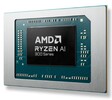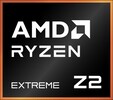AMD Ryzen AI 7 PRO 360 vs AMD Ryzen Z2 Extreme
AMD Ryzen AI 7 PRO 360
► remove from comparison
The Ryzen AI 7 PRO 360 is a relatively powerful Strix Point family processor that debuted in October 2024. The hybrid architecture APU has 8 CPU cores onboard (a mix of three Zen 5 and five Zen 5c cores) running at 2.0 to 5.0 GHz, along with the 12 CU RDNA 3.5 Radeon 880M graphics adapter and the 50 TOPS XDNA 2 neural engine. The AMD Secure Processor (which in a nutshell is an on-package ARM co-processor) is onboard as well as are a few other higher-end features such as AMD-Vi. Other key features include PCIe 4, USB 4 and up to LPDDR5x-8000 RAM support, including ECC RAM.
Architecture and Features
Strix Point family APUs are powered by Zen 5 and Zen 5c microarchitecture cores found in two separate clusters, the latter being a slightly slower, smaller and more energy-efficient version of the former. One of the differences between Zen 5 and Zen 5c is cache size; Zen 5 cores have larger caches to work with.
Either way, mobile Zen 5 implementation is reportedly (ChipsAndCheese) closer to desktop Zen 4 than to desktop Zen 5 due to differing cache sizes, vast differences in AVX-512 throughput and other factors.
Elsewhere, the Ryzen AI 7 PRO chip supports DDR5-5600 and LPDDR5x-8000 RAM, giving system designers a choice between lower latency and higher throughput respectively. The chip is natively compatible with USB 4 (and therefore Thunderbolt). It has PCIe 4.0 support for a throughput of 1.9 GB/s per lane, just like its 8000 series predecessors did. The integrated XDNA 2 NPU, which is a lot more complex than first-gen XDNA was, delivers up to 50 INT8 TOPS for accelerating various AI workloads.
As is usual for laptop CPUs, the Ryzen 7 AI PRO chip is not user-replaceable as it gets soldered down for good.
Performance
We fully expect this PRO series processor to be 15% to 25% slower than the 10-core Ryzen AI 9 365 chip for Core Ultra 7 155U-like multi-thread benchmark scores. Of course, a lot depends on how high the power targets are which can differ vastly between designs.
Graphics
The Radeon 880M is the direct successor to the 780M. It packs several differences under the hood, such as faster caches; its 12 RDNA 3.5 architecture CUs/WGPs (768 unified shaders) run at up to 2,900 MHz. With well over 30 fps in both Once Human and The First Descendant (1080p - Low), this AMD iGPU is certainly fast enough for a fair bit of casual as well as competitive gaming.
Naturally, the Radeon is capable of driving four SUHD 4320p60 monitors. It can also efficiently encode and decode the most popular video codecs such as AVC, HEVC, VP9 and AV1. The latest addition to that list, the VVC codec, is not supported unlike it is with Intel Lunar Lake chips.
Power consumption
The 360 is supposed to have a low-term TDP power target of 28 W, with laptop makers free to crank it up to up to 54 W. Which they will most likely do to maximize performance.
The 4 nm TSMC process that these CPUs are built with makes for above average, as of late 2024, energy efficiency.
AMD Ryzen Z2 Extreme
► remove from comparison
The Ryzen Z2 Extreme is a relatively powerful Strix Point family processor that debuted in early 2025. The hybrid architecture APU has 8 CPU cores onboard (a mix of three Zen 5 and five Zen 5c cores) running at 2.0 to 5.0 GHz, along with the 16 CU RDNA 3.5 Radeon 880M graphics adapter and the 50 TOPS XDNA 2 neural engine. Compared to the similar Ryzen AI 7 PRO 360, the Z2 Extreme does not offer the Ryzen AI NPU.
Architecture and Features
Strix Point family APUs are powered by Zen 5 and Zen 5c microarchitecture cores found in two separate clusters, the latter being a slightly slower, smaller and more energy-efficient version of the former. One of the differences between Zen 5 and Zen 5c is cache size; Zen 5 cores have larger caches to work with.
Either way, mobile Zen 5 implementation is reportedly (ChipsAndCheese) closer to desktop Zen 4 than to desktop Zen 5 due to differing cache sizes, vast differences in AVX-512 throughput and other factors.
Elsewhere, the Ryzen chip supports DDR5-5600 and LPDDR5x-8000 RAM, giving system designers a choice between lower latency and higher throughput respectively. The chip is natively compatible with USB 4 (and therefore Thunderbolt). It has PCIe 4.0 support for a throughput of 1.9 GB/s per lane, just like its 8000 series predecessors did. The integrated XDNA 2 NPU, which is a lot more complex than first-gen XDNA was, delivers up to 50 INT8 TOPS for accelerating various AI workloads.
As is usual for mobile CPUs, the Ryzen 7 AI PRO chip is not user-replaceable as it gets soldered down for good.
Performance
The performance should be similar to the Ryzen AI 7 PRO 360 due to the similar specs, but limited due to TDP and heat restrictions in handhelds.
Graphics
The Radeon 880M is the direct successor to the 780M. It packs several differences under the hood, such as faster caches; its 16 RDNA 3.5 architecture CUs/WGPs (768 unified shaders) run at a currently undisclosed clock speed. With well over 30 fps in both Once Human and The First Descendant (1080p - Low), this AMD iGPU is usually certainly fast enough for a fair bit of casual as well as competitive gaming.
Power consumption
The Z2 Extreme is supposed to have a low-term TDP power target of 28 W, with handheld makers free to set between 15 and 35 W.
The 4 nm TSMC process that these CPUs are built with makes for above average, as of late 2024, energy efficiency.
| Model | AMD Ryzen AI 7 PRO 360 | AMD Ryzen Z2 Extreme | ||||||||||||||||||||||||
| Codename | Strix Point (Zen 5) | Strix Point (Zen 5) | ||||||||||||||||||||||||
| Series | AMD Strix Halo/Point (Zen 5/5c, Ryzen AI 300) | AMD Strix Halo/Point (Zen 5/5c, Ryzen AI 300) | ||||||||||||||||||||||||
| Series: Strix Halo/Point (Zen 5/5c, Ryzen AI 300) Strix Point (Zen 5) |
|
| ||||||||||||||||||||||||
| Clock | 2000 - 5000 MHz | 2000 - 5000 MHz | ||||||||||||||||||||||||
| L2 Cache | 8 MB | 8 MB | ||||||||||||||||||||||||
| L3 Cache | 16 MB | 16 MB | ||||||||||||||||||||||||
| Cores / Threads | 8 / 16 3 x 5.0 GHz AMD Zen 5 5 x 3.3 GHz AMD Zen 5c | 8 / 16 3 x 5.0 GHz AMD Zen 5 5 x 3.3 GHz AMD Zen 5c | ||||||||||||||||||||||||
| TDP | 28 Watt | 15 Watt | ||||||||||||||||||||||||
| TDP Turbo PL2 | 54 Watt | |||||||||||||||||||||||||
| Technology | 4 nm | 4 nm | ||||||||||||||||||||||||
| Socket | FP8 | FP8 | ||||||||||||||||||||||||
| Features | DDR5-5600/LPDDR5x-8000 RAM, PCIe 4, USB 4, XDNA 2 NPU (50 TOPS), Secure Processor, SMT, AES, AVX, AVX2, AVX512, FMA3, MMX (+), SHA, SSE, SSE2, SSE3, SSSE3, SSE4.1, SSE4.2, SSE4A | DDR5-5600/LPDDR5x-8000 RAM, PCIe 4, USB 4, XDNA 2 NPU (50 TOPS), Secure Processor, SMT, AES, AVX, AVX2, AVX512, FMA3, MMX (+), SHA, SSE, SSE2, SSE3, SSSE3, SSE4.1, SSE4.2, SSE4A | ||||||||||||||||||||||||
| iGPU | AMD Radeon 880M ( - 2900 MHz) | AMD Radeon 890M | ||||||||||||||||||||||||
| Architecture | x86 | x86 | ||||||||||||||||||||||||
| Announced | ||||||||||||||||||||||||||
| Manufacturer | www.amd.com | www.amd.com |
Benchmarks
Average Benchmarks AMD Ryzen AI 7 PRO 360 → 100% n=2
Average Benchmarks AMD Ryzen Z2 Extreme → 100% n=2
* Smaller numbers mean a higher performance
1 This benchmark is not used for the average calculation













